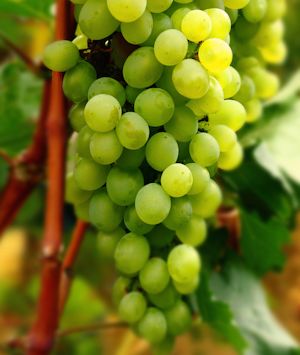Robert Bell's
Wines of Canada
Since 1992
Grape Varieties
British Columbia
According to various sources the number one planted grape in BC is Merlot 1,585 acres or 641 hectares . For white wines most planted grape is Pinot Gris with 1,132 acres planted or 458 hectares as of Sepy 2019.
Pinot Noir has grown more rapidly in terms of acreage (79% between 2006 and 2014) than any other widely planted red grape with 11,000 acres.
Hybrids: When this term is used in the British Columbia wine industry, it refers to grape varieties created by crossing two different grape species, for example, crossing Vitis labrusca or Vitis riparia, two native North American species, with Europe's Vitis vinifera. The nineteenth century and early twentieth French plant breeders, who developed many of the hybrids in a search for disease-resistant vines, are still remembered in the names of some hybrids. Baco Noir was named for Maurice Baco; seyval blanc for Bertille Seyve-Villard; vidal for J.L. Vidal. One of the most prolific hybridizers was Albert Seibel, who churned out a long list of vines simply designated with his name and a number, such as Seibel 9549, Seibel 9110 and Seibel 10878.
In North America, these hybrids first were widely grown in Ontario and New York and in 1970 the Finger Lakes Wine Growers Association gave more commercially-acceptable names to the popular Seibel hybrids. Thus 9110 became verdelet, 10878 became chelois, Seibel 5898 became rougeon and Seibel 7053 became chancellor. The name assigned to 9549 was "cameo" but the Canadian Wine Institute objected, in part because that already was a proprietary name used by one Canadian winery. In 1972 it was agreed to call 9549 de chaunac, named after Adhemar de Chaunac, the veteran winemaker at T.G. Bright & Co. in Niagara Falls who had convinced his company to import many hybrid varieties from France.The European Union no longer permits the use of hybrid varieties in the production of "quality" wines, which includes all wines made under controlled appellation rules.
Hybrid varieties still may be used in wines which qualify for the Vintners Quality Alliance in British Columbia even though most hybrids were pulled out after the 1988 harvest. The poor wines formerly made from, for example, ineptly-grown de chaunac or the characterless verdelet earned such a bad reputation for hybrids among consumers that most wineries cannot sell even well-made examples for reasonable prices. As a result growers and wineries alike have switched to the more remunerative vinifera vines and wines. However, an unexpected surge in red wine demand in the mid-1990s revived interest in such full-flavored hybrids as maréchal foch (originally Kuhlmann 188-2 after hybridizer Eugene Kuhlmann), rougeon and chancellor.
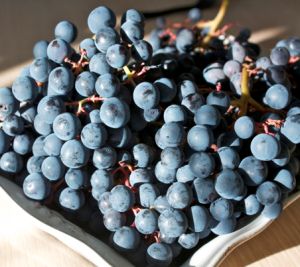 |
Agria: is an early ripping grape suited to cool climate vineyards
Agria is also known as Turan. Agria's chief attributes are its dark color, high vigour growth, cool climate friendly and ripens early with good sugar content. It grows well in the Pacific Northwest.
Isla de Lerena Vineyard on Hornby Island of the Coast of British Columbia grows Agria.
Cherry Point has a blend using Castel, Agria and Zweigelt grapes
|
 |
Albarino: is a high-quality, light-bodied white wine that grows primarily in Spain and Portugal. It's loved for its high acidity, refreshing citrus flavors, dry taste, and subtle saltiness.
For seafood lovers, Albariño is a fantastic choice for food pairing with exquisite dishes like ceviche, fish tacos, ...
Stag's Hallow is a producer
|
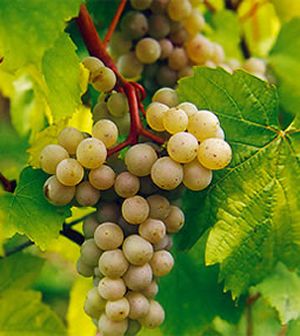 |
Auxerrois: (ox-er-wah) Produces a white table wine sometimes referred to as Pinto Auxerrios.
Pinot Auxerrois
another of the various clones of Pinot Noir, Auxerrois Blanc is a light white grape with qualities that range from neutrality to honey to asparagus, all dependent upon production method and oak aging.
Gray Monk (BC) grows Pinot Auxerrois
as does Gehringer Brothers. Little Straw has grown Auxerrois since 1974.
Their white blends Tapestry and Cuvée Blanc using Auxerrois are well known. They also make Auxerrois icewine.
In Ontario it is Viewpoint winery's most popular white. Auxerrois Crops well (4-4.5 Tones/acre). Cold hardy to about -22 C. Early harvest – 1 st week of September hence good ripeness levels. Sugars similar to Riesling although the acids are usually much lower.
|
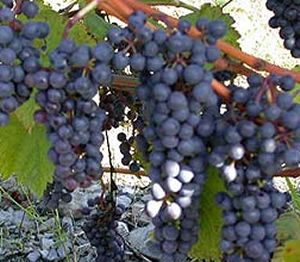 |
Baco Noir: is a hybrid red grape variety that was produced by crossing two other grapes: a Vitis vinifera (Folle Blanche, a French wine grape) and an unknown variety of Vitis Riparia (an American wine grape). Created by French wine hybridizer Maurice Baco, it was at once commonly grown in France, but was heavily restricted for commercial use in 1951 by European Union regulations. At the same time, the variety was brought to the cooler viticulture regions of the United States, such as New York, Michigan, Mississippi, Wisconsin, and Pennsylvania and a few years later to Canada.
This hearty, early-ripening true north varietal is used wholly and in blends to produce medium-bodied, fruit forward and structured wines with concentrated red berry, wood, and spice flavours and relatively high acidity. Some of its best renditions are produced in Ontario and British Columbia.
|
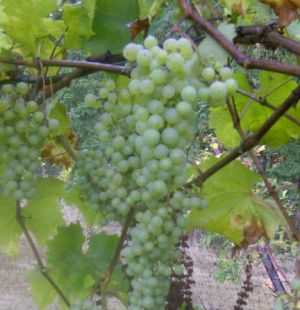 |
Blattner: is a Hybrid not commonly grown. But has found a home in the BC Coastal Areas. There is a red and white varietal. The grape of various clones were developed by
Valentine Blattner a swiss winemaker.
The Blattner White wine
has notes of apple pear and honey. Reminds one of Alsatian Riesling,.
Salt Spring Vineyards winemaker Paul Troop introduced Blattner blends to the Islands. We believe that they offer a good alternative to the standard grape types that we have such a difficult time ripening in our cool climate.We believe in working toward a unique Coastal identity.
Averill Creek, Alderlea, Rocky Creek also have Blattners on Vancouver Island. In the Fraser Valley , Mt. Lehman and Lotusland grow them.
Rocky Creek grows the Cab-Foch a red with tendencies to taste like a Cabernet Sauvignon, but is early ripening, & disease resistant
Unsworth on the Island, Blattner varieties planted which include 2 whites; 48-05-49 and Epicure, and three reds; La Belle, Cabernet Libre and 48-05-83. Ovino Winery in the sunny Shuswap
is testing Blattner and petit milo
|
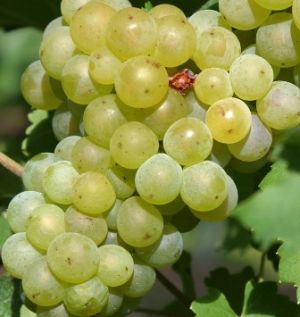 |
Bacchus: is a white wine grape that was created by viticulturalist Peter Morio at the Geilweilerhof Institute for Grape Breeding in the Palatinate in 1933. He crossed a Silvaner x Riesling cross with Müller-Thurgau .Bacchus received varietal protection and was released for general cultivation in 1972.
Bacchus is the signature wine of Domaine De Chaberton Estate Winery in Langley British Columbia. In BC Bacchus grape production is less than 1 % of all grapes grown in the province. Arrowleaf is another BC producer of Bacchus. Blue Grouse on Vancouver Island as well.
|
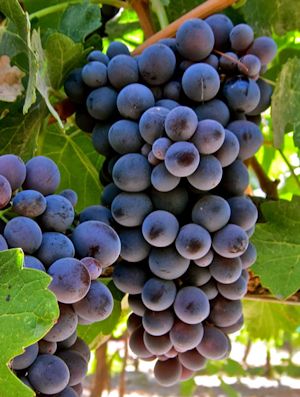 |
Barbera:
is a red Italian wine grape variety that, as of 2000, was the third most-planted red grape variety in Italy (after Sangiovese and Montepulciano ). It produces good yields and is known for deep color, low tannins and high levels of acid a
few small acreage are planted in British Columbia. It produces an intense red wine with deep color, low and high acid.
In Washington State , producers have been experimenting with plantings of Barber in the Red Mountain , Walla Walla , and Columbia Valley AVAs . So far these very young vines have produced fruity wines with strawberry notes and limited complexity and aging potential. In addition to Washington, in the Umpqua AVA of Oregon plantings of Barbara are proving successful
Howard Soon of Sandhill grows
Barbera (sometimes the a is added)
Tightrope uses the grape
|
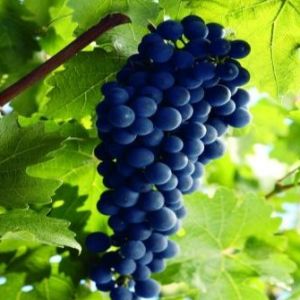 |
Cabernet Sauvignon is one of the world's most widely recognized red wine grape varieties.
Cabernet Sauvignon became internationally recognized through its prominence in Bordeaux wines where it is often blended with Merlot and Cabernet Franc . From France , the grape spread across Europe and to the New World where it found new homes in places like California's Napa Valley , Australia's Coonawarra region Chile's Maipo Valley and British Columbia's Okanagan.
Despite its prominence in the industry, the grape is a relatively new variety, the product of a chance crossing between Cabernet franc and Sauvignon blanc during the 17th century in southwestern France . Its popularity is often attributed to its ease of cultivation—the grapes have thick skins and the vines are hardy and resistant to rot and frost —and to its consistent presentation of structure and flavours which express the typical character
(" typicity ") of the variety.
Good producers include Inniskillin Okanagan, Monster Vineyards, Quinta Ferrereira and
Pentâge
|
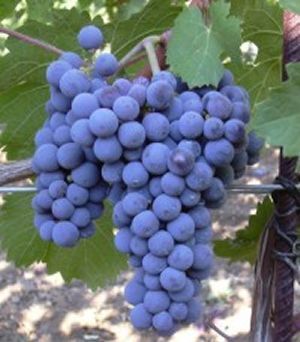 |
Cabernet Franc is one of the major black grape varieties worldwide. It is principally grown for blending with Cabernet Sauvignon and Merlot in the Bordeaux style, but can also be vinified alone
In addition to being used in blends and produced as a varietal in Canada and the United States it is made into icewine.
the flavor profile of Cabernet Franc may be both fruitier and sometimes more herbal or vegetative than Cabernet Sauvignon, although lighter in both color and softer in tannins
Black Sage Bench in BC's Okanagan is a great place for Cabernet Franc.
Tinhorn Creek produces good wines from their Vineyard here.
Popular Grove and Nichol Vineyards in Naramata are also producers
Gold Hill Winery in Kelowna another good producer. Fort Berens Estate excellent wine. Painted Rock makes some amazing blends with their Cabernet Franc .
Ovino Winery in the north Okanagan also grows Cab Franc. Award winning Cabernet Franc Icewine comes from Inniskillin.
The grape is often used in Blends like Herder Winery's Josephine
|
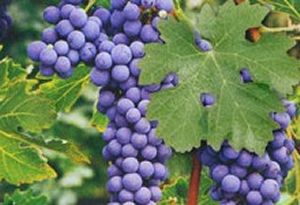 |
Carménère is a wine grape variety originally planted in the Médoc region of Bordeaux , France , where it was used to produce deep red wines and occasionally used for blending purposes in the same manner as Petit Verdot .
Okanagan's Black Hills Estate Winery created a sensation in 2004 by releasing, very quietly, the first varietal red wine made from the Carmenère grape.
Senka Tennant made the first wine from it in 2005
Lariana Cellars in Osoyoos grows Carménère
Chile has had success with Carménère
|
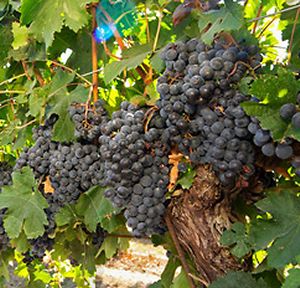 |
Castel is a French American hybrid (specifically a V. riparia X Gamay cross), which was bred to take severe winters, ripen early with high Brix (fermentable sugar) and produce big crops. Produces red wine.
It has limited use in BC but is more prominent in Nova Scotia. Domain de Grand Pre was won Gold for their Castel
Damali the Vineyard on Vancouver Island grows Castel for their blends.
|
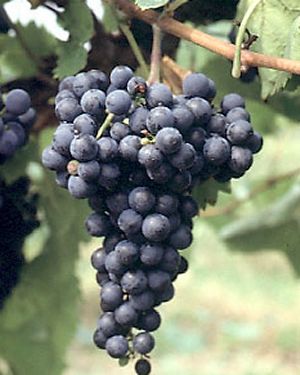 |
Chancellor is a hybrid wine grape variety produced by Albert Seibel circa 1860. It is also known as Seibel 7053 and is a cross of Seibel 5163 and Seibel 880.
Produces a fruity wine with notes of raspberry and cherry . It is susceptible to both downy and powdery mildew .
this variety ripens late and has a semi-trailing growth pattern. Moderate winter hardiness needs protection. Requires cluster thinning.
Produces a fruity wine with notes of raspberry and cherry
Limited production in British Columbia.
Rustico Farm and Cellar uses Chancellor in their
Last Chance blend.
|
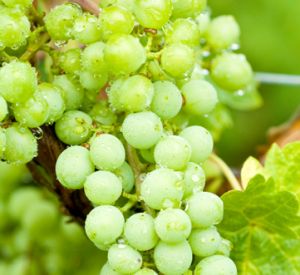 |
Chardonnay grape is green-skinned and is believed to have originated in the Burgundy wine region of eastern France but is now grown all over the world wherever wine is produced. It is a relatively “low-maintenance” vine that adapts well to a variety of climates, resulting in fairly high yields worldwide In Canada they are best grown in British Columbia and Ontario.
Chardonnay has also been grown in Nova Scotia. Blomidon Estate Winery makes 100% gown Chardonnay. Gaspereau Vineyards is another Nova Scotia producer of Chardonnay along with their traditional method Chardonnay Brut sparkling wine.
Les Pervenches, near Farnham in Quebec's Eastern Townships was among the first in Quebec to grow Chardonnay. Taws in Ontario produces great Chardonnay and Chardonnay icewine.
Chardonnay's boast an impressive range of flavors from the expected buttered, oak overtones to the fresh, fruit flavors of apple, pear, tropical, citrus and melon, leaving a lasting palate impression.
Some good producers are Calamus,
|
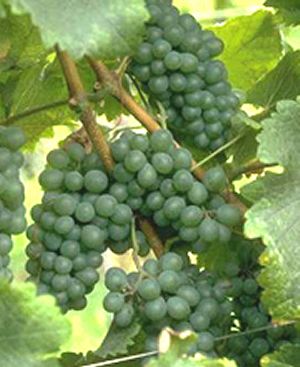 |
Chenin blanc (known also as Pineau de la Loire among other names ), is a white wine grape variety from the Loire valley of France . Its high acidity means it can be used to make everything from sparkling wines to well-balanced dessert wines , although it can produce very bland, neutral wines if the vine's natural vigor is not controlled.
it is found in most of the New World wine regions.
Quails' Gate Chenin Blanc has been served to numerous visiting Heads of State including President Obama and the future King and Queen of England, William and Kate. Road 13 Vineyards also produces an Old Vine Chenin blanc
Chenin is one of the most versatile grape varieties. Crisp semi-sweet to dry wines, sparkling wine, dessert wines, and even brandies are most from this grape.
Stoney Ridge Cellars Ltd and Cave Springs in Ontario makes a very nice icewine.
Its also used in Washington State for icewine.
|
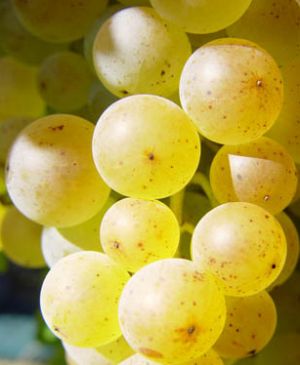 |
Chasselas or Chasselas Blanc a variety grown in Switzerland , France , Germany, Portugal, Hungary , Romania and New Zealand . Chasselas is mostly vinified to be a full, dry and fruity white wine. It makes a good patio wine
Chasselas was the first viniferia grown t the Gray Monk Estate and subsequently became their first wine. St Hubertus in Kelowna is another noted producer of Chasselas.
Quails Gate and Gray Monk make a Chasselas Pinot Blanc Pinot Gris blend
|
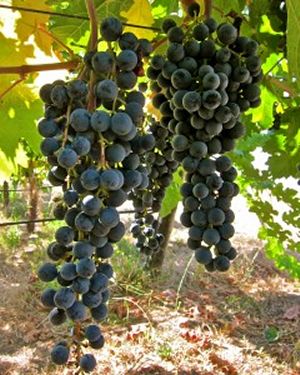 |
Dornfelder : an immensely popular German red wine grape; a 1955 crossing of Helfensteiner (Frühburgunder × Trollinger) and Heroldrebe
De Vine on Vancouver Island produces a Dornfelder wine-
ripe, fruity German red with intense color and an aroma of spruce tips and elderberries.
8th Generation Confidence Frizzante style uses 50% Dornfelder along with
Pinot Gris and Syrah
The Ice House winery in Ontario makes a Cabernet/ Dornfelder icewine.
Also grown in Quebec.
|
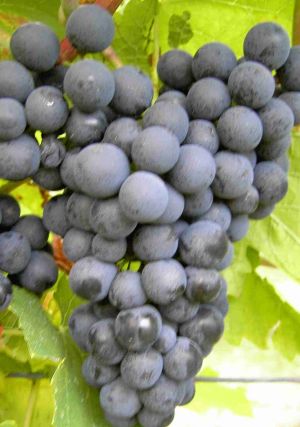 |
Dunkelfelder is a dark-skinned variety of grape used for red wine . It was created by German viticulturalist Gustav Adolf Froelich (1847-1912). He probably crossed Färbertraube (a teinturier ) with Blauer Portugieser .The variety, initially called Froelich V 4-4, did not receive any attention for several decades until work was continued on it at Geisenheim grape breeding institute in the 1930s. It was named Dunkelfelder ( dunkel = dark) by ampelographer Helmut Becker , due to its unclear parentage and its dark colour. Dunkelfelder received varietal protection and was released for general cultivation in 1980.
Blue Grouse on Vancouver Island been one producer.
|
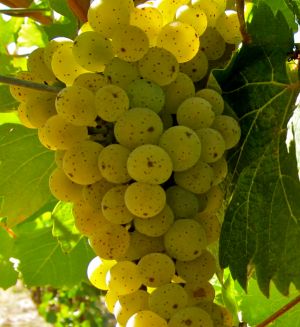 |
Ehrenfelser is a white wine grape variety of German origin. It was created by Dr. Heinrich Birk (1898-1973) at the Geisenheim Grape Breeding Institute in 1929, by crossing the varieties Riesling and Silvaner , with the identification of Silvaner being somewhat uncertain.
Several vineyards in the Okanagan Valley of British Columbia also grow Ehrenfelser, including Summerhill,Lake Breeze, Fitzpatrick Family Vineyards, Gehringer Brothers, Mount Boucherie and Summerhill. The grape tends to ripen earlier and produce higher yields than Riesling but its quality is not on par with that of this, its parent grape
Your taste buds will find sweet grapefruit, green apple and a hint of honey.
|
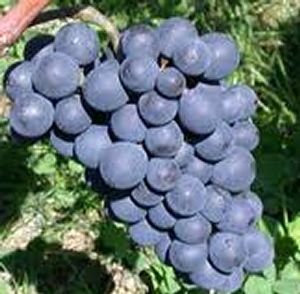 |
Gamay is a purple-colored grape variety used to make red wines , most notably grown in Beaujolais and in the Loire Valley Its full name is Gamay Noir à Jus Blanc. It is a very old cultivar , mentioned as long ago as the 15th century. It has been often cultivated because it makes for abundant production; however, it can produce wines of distinction when planted on acidic soils, which help to soften the grape's naturally high acidity
Gamay is grown in the BC Okanagan, and Ontario
Gray Monk produces a nice Gamay Noir wine. Other fine wines come from Domaine de Chaberton, Beaumont Estate Vineyards, Volcanic Hills,
Pentâge,Deol Estate,Haywire, Bluemountain and Desert Hills. Also Robin Ridge in the Similkameen Valley.
St. Hubertus makes a Gamay Noir Rose
Bella Wines produces a nice Sparkling Gamay.
|
 |
Gewürztraminer is an aromatic wine grape variety, used in white
wines , and performs best in cooler climates. It is sometimes referred to colloquially as Gewürz . Gewürztraminer is a variety with a pink to red skin colour, which makes it a "white wine grape" as opposed to the blue to black-skinned varieties commonly referred to as "red wine grapes". The variety has high natural sugar and the wines are white and usually off-dry , with a flamboyant bouquet of lychees . Indeed, Gewürztraminer and lychees share the same aroma compounds .Dry Gewürztraminer's may also have aromas of roses, passion fruit and floral notes. It is not uncommon to notice some spritz (fine bubbles on the inside of the glass)
It accounts for about 8% of all grape production in BC it is on the increase
Gray Monk is a good BC producer. Summerhill Pyramid Winery makes an Organic Gewürztraminer. Kalala and Tinhorn Creek are noted producers.
Pelee Island and Tawse in Ontario ar good producers
|
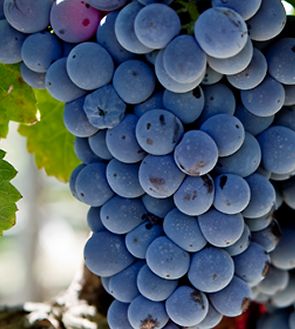 |
Grenache (pronounced gren-aash ) is one of the most widely planted red wine grape varieties in the world. It ripens late, so it needs hot, dry conditions such as those found in Spain , the south of France , and California. It is generally spicy, berry-flavored and soft on the palate with a relatively high alcohol content , but it needs careful control of yields for best results. It tends to lack acid , tannin and color , and is usually blended with other varieties such as Syrah , Carignan , Tempranillo and Cinsaut .
Its use in BC is more experimental.
Stag Hallow release a Grenache in Sept 2013.
|
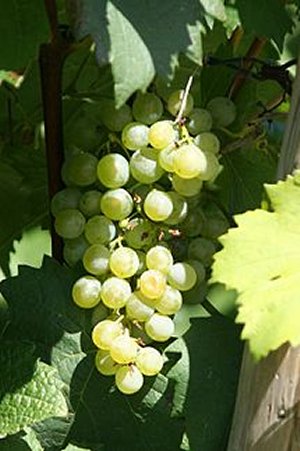 |
Grüner Veltliner ( German pronunciation: ['g?y?n? v?lt'li?n?] ) of white wine grape variety grown primarily in Austria , Slovakia , and the Czech Republic . It has a reputation of being a particularly food-friendly wine . It is made into wines of many different styles
Summerhill Pyramid is planting in the Okanagan.
Some of our favourite examples are minerally with a hint of celery leaf. It makes some very distinctive, delicious wines
|
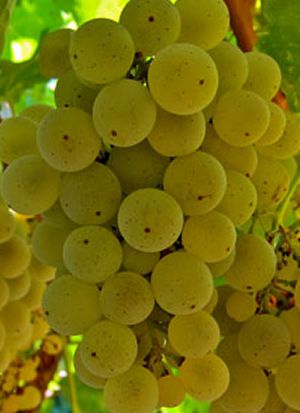 |
Kerner is an aromatic white grape variety. It was bred in 1929 by August Herold by crossing Trollinger (a red variety also known as Schiava grossa or Vernatsch) and Riesling. Herold was working at a plant breeding station in Lauffen in the Württemberg region of Germany . This station belonged to a state breeding institute headquartered. It received varietal protection and was released for general cultivation in 1969
Oliver Twist in Oliver produces a Kerner wine.
Baillie-Grohman Estate Winery in Creston also grows Kerner. Summergate produces an Organic Kerner. Tinhorn makes a very nice Kerner Icewine.
Rief Estates in Ontario makes a Kerner Nouveau.
Kerner Reserve made by Diamond Estates.
Tasting notes bouquet of white peach, with a while round creamy mid-palate with hints of lime and ripe apricot. Sweet juicy long lasting finish.
|
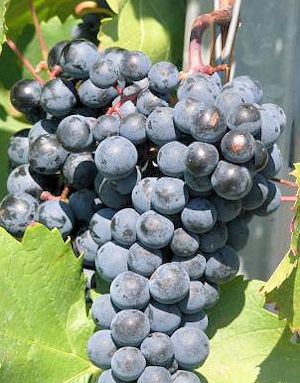 |
Lemberger Officially classified under the name “Blauer Limberger,” this red grape variety also goes by the synonyms “Lemberger” and Blaufränkisch. The late-ripening Lemberger probably originated in vineyards on the lower stretches of the Danube River.
Cold-hardy red wine grape with mild tannins and a chocolate raspberry flavour. Wines made from this grape can often have low levels of histamines.
Hainle winery may have made the first Lemberger wine in BC 1987 using grapes grown in Similkameen Valley. It was popular in Washington.
Its use has decline in BC.
Ancient Hills Kelowna planted Lemberger in 2005 used in blends. Blasted Church uses it for blends.
Larch Hill in Salmon Arms grows Lemberger making a dessert wine.
|
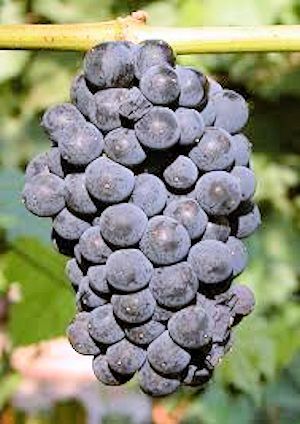 |
Léon Millot is a red variety of hybrid grape; it was created in 1911 in the Oberlin Institute in Colmar, Alsace , by the French viticulturist Eugène Kuhlmann (1858–1932) by crossing the hybrid grape Millardet et Grasset 101-14 O.P. (which is Vitis riparia × Vitis rupestris ) with Goldriesling , which is Vitis vinifera . The variety was named after the winemaker and tree nursery owner Léon Millot.
Léon Millot ripens early, and has high resistance against fungal diseases. It is therefore suited for cultivation in colder climates. It gives powerful wine with some foxy aromas
Saxon Winery in Summerland grows the grape.
Beaufort Estate-grown Leon Millot used in Blends. Mistaken Identity, Gary Oaks, and Salt Spring Winery on Salt Spring Island are growers.
Léon Millot is popular in New Brunswick and Nova Scotia.
|
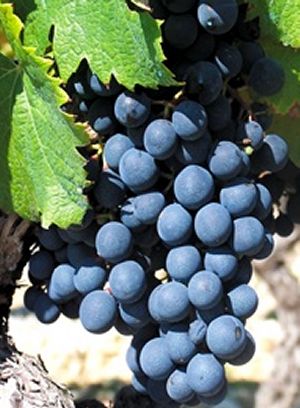 |
Malbec ( pronounced: [mal.b?k] ) is a purple grape variety used in making red wine . The grapes tend to have an inky dark color and robust tannins , and are known as one of the six grapes allowed in the blend of red Bordeaux wine .
The grape can be found almost world wide.
It does well in Argentina. The Malbec grape is a thin-skinned grape and needs more sun and heat than either Cabernet Sauvignon or Merlot to mature. It ripens mid-season and can bring very deep color, ample tannin , and a particular plum-like flavor component to add complexity to claret blends
Desert Hills, Cassini Cellars,and Inniskillin
in Oliver produces Malbec Wine. CedarCreek Kelowna has it. River Stones has a Malbec Rose. Malbec is often used in blends like Hester Creek's Character Red and Hillside Winery's Merlot Malbec
Malbec is also found in Ontario
|
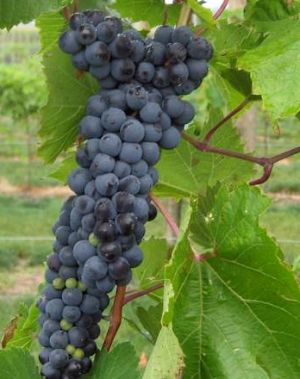 |
Marechal Foch (pronounced "mar-esh-shall-fosh"), is an inter-specific hybrid red grape variety. It was named after the French marshal Ferdinand Foch (1851-1929), who played an important role in the negotiation of the armistice terms during the closing of the First World War .
It was developed in Alsace , France by grape hybridizer Eugene Kuhlmann. It ripens early , is cold-hardy, is resistant to fungal diseases, but because of its small berry size is prone to bird injury. The quality of wine produced by Marechal Foch vines is highly dependent upon vine age, and the flavor profile associated with many new-world hybrid varietals is much reduced in examples made with fruit picked from older vines. The berry size of this variety is small.
The grape is gaining popularity in the Northwest.
Quails' Gate virtually saved the variety in British Columbia, even starting a modest comeback, when the winery crafted its first Old Vines Foch wine in the 1994 vintage (1)
Excellent wines from the variety are made in British Columbia by such producers as Alderlea Vineyards, Starling Lane, Larch Hills, Skimmerhorn and Sperling Vineyards, among others including
Niche Wine Company, St Hubertus Oak Bay in Kelowna and
Beaufort Estate on Vancouver Island.
It is often found in blends like Larch Hill's
Grandview Bench Red 2010
Full flavour, dark colour, blend of Marechal Foch, Lemberger & Merlot
|
 |
Marsanne is a white wine grape, most commonly found in the Northern Rhône region. It is often blended with Roussanne. In Savoie the grape is known as grosse roussette. Outside France it is also grown in Switzerland, Spain, Australia, New Zealand, Canada and the United States.
Only a few vineyards grow Marsanne, Road 13 is one. Pentage, Popular Grove and Le Vieux Pin uses it in some blends.
Church and State
|
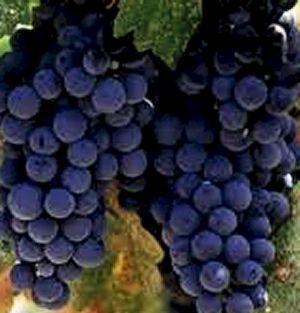 |
Merlot is a darkly blue-coloured wine grape , that is used as both a blending grape and for varietal wines. The name Merlot is thought to derive from the Old French word for young blackbird, merlot, a diminutive of merle, the blackbird ( Turdus merula ), probably from the color of the grape. Merlot-based wines usually have medium body with hints of berry , plum , and currant . Its softness and "fleshiness", combined with its earlier ripening
"everybody knows Merlot"
By far it is the number one Varietal grown in British Columbia.
Historically, merlot is B.C.'s strongest red. Stag's Hallow, Tinhorn Creek, Gray Monk, Hester Creek, Township 7, Painted Rock, Sumac,
Nk'Mip, Quinta Ferreira, Mission Hill, Intrigue, Blasted Church, Blackwood Lane,
Seven Stones and so many more produce great Merlot wines.
|
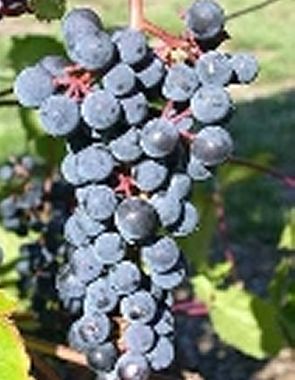 |
Michurinets is an east European grape of high vigor. a Vitis vinifera and Vitis Amurensis
hybrid .Capable of producing a fine Cabernet Sauvignon style red wine! Requires cluster thinning of secondary late clusters and side shoots. Fruit will fall when over ripe. Susceptible to Powdery Mildew. Winter hardy to at least -24F. Buds rather late. Widely grown in Eastern Europe. Space 8 ft apart on high wire trellis
An experimental grape in BC. More popular in Nova Scotia. It can be found in Quebec
|
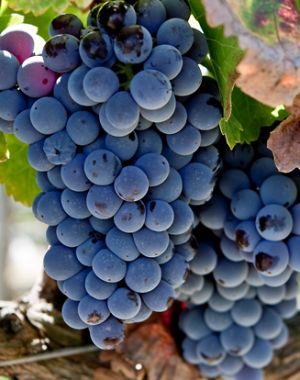 |
Mourvèdre (also known as Mataró or Monastrell ) is a red wine variety that is grown in many regions around the world regions of France , the Valencia and Spain , California and Washington State and the Australian regions of South Australia and New South Wales . In addition to making red varietal wines, Mourvèdre is a prominent component in "GSM" blends where it is blended with Grenache and Syrah . The variety is also used to make rosé and port-style fortified wines .
Mourvèdre tends to produce tannic wines that can be high in alcohol. The style of wine produced from the grapes varies greatly according to where it is produced
Road 13 makes a Syrah Mourvedre Reserve Rose 2011
Red Rooster blends Mourvedre and Grenachee to produce a Rhone blend
3.82 acres of Mourvedre planted in the Okanagan Valley this wine is beyond rare. - Red Rooster
|
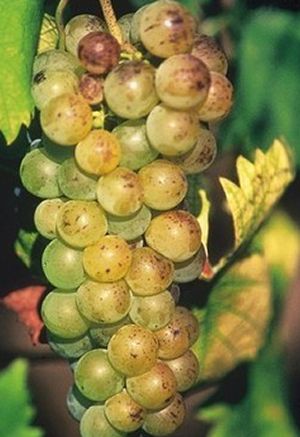 |
Muscat v species Vitis vinifera is widely grown for wine , raisins and table grapes . Their color ranges from white to near black. Muscat almost always has a pronounced sweet floral aroma . Muscat grapes are grown around the world. The breadth and number of varieties of muscat suggest that it is perhaps the oldest domesticated grape variety, and there are theories that most families within the Vitis vinifera grape variety are descended from the Muscat variety
Muscat Blanc: is the most popular varietal. Is marked by a pale yellow colour and floral notes. Muscat Blanc is pictured.
Muscat Ottonel is often used in dessert wines.
Black Muscat and Orange Muscat: more high-end, dessert wine Orange Muscat is more common in California.
Joies Farm Winery in the Naramata produces muscat wine. SilkScarf produces a Riesling Muscat.
|
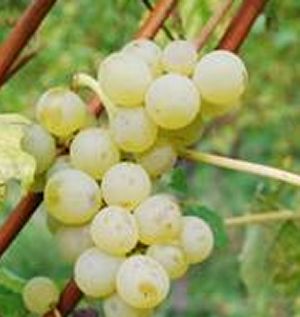 |
Muscat Ottonel or Muskat-Ottonel (in Germany ) is a white wine grape that is a member of the Muscat family of Vitis vinifera . It is most notable for its use in dessert wines from Austria , Croatia and Serbia as well as dry wines from Alsace and Hungary
Muscat Ottonel is more cold-hardy than its relatives.
The variety has also established itself in Canadian vineyards in Ontario and British Columbia
Hillside Estate winery in Naramata is the leader of producing quality wines from Muscat Ottonel in BC. Summergate also makes one. Tinhorn uses it in their Oldfield 2 Bench White.
|
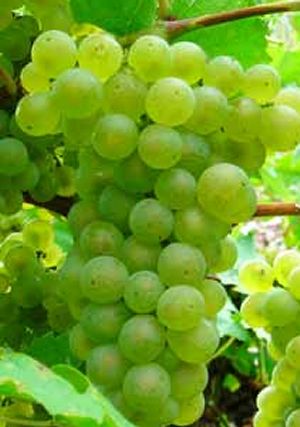 |
Müller-Thurgau is Germany's second most planted grape. It is planted in every wine region and covers 34,565 acres (13,988 hectares), accounting for 13.7% of Germany's vineyards.
a variety of white grape (sp. Vitis vinifera ) which was created by Hermann Müller from the Swiss Canton of Thurgau in 1882. It is a crossing of Riesling with Madeleine Royale.
A few grapes are grown in BC .. Blue Grouse on Vancouver Island been one producer. Stoneboat's Chorus is an intriguing concoction of six grapes (Pinot Gris, Pinot Blanc, Viognier, Muller Thurgau, Kerner, Schoenburger), the perfumed nose is promising of delicious, juicy tropical fruits
Also found in Oregon
|
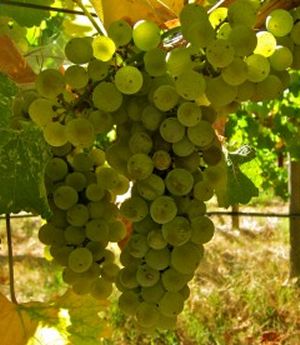 |
Oraniensteiner it is a white-wine producing variety released by the Geisenheim Research Institute in 1985 and is the result of a Riesling x Silvaner (Gruen) crossing
grown by Sonoran Estate winery in Summerland. They also make icewine with Oraniensteiner.
|
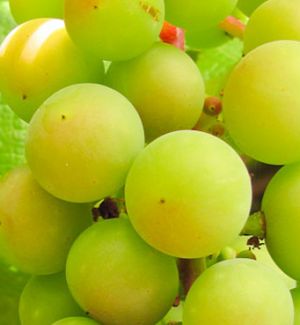 |
Ortega Across between Muller-Thurgau and Siegerrebe varieties mostly used for white wine blending. Cold-hardy grape found in Germany and Canada. Comparable to Riesling.
Ortega ripens early, is not sensitive to frost and reaches quite high must weights , typically 20 degrees Oechsle higher than Müller-Thurgau. It is therefore often used for sweet wines, which are considered to improve with cellaring. Ortega wines have aromas of Muscat and peach and are high in extract
Ortega's winter-hardy character has allowed this grape to be successfully grown in British Columbia, and with limited success in Canada's eastern province of Nova Scotia
Larch Hill Winery in Salmon Arms is a good producer or Ortega. Enrico,
Dragonfly Hill and Muse on Vancouver Island and Mistaken Identity on Salt Spring Island are good producers. Domaine de Chaberton in the Fraser valley grows ortega.
|
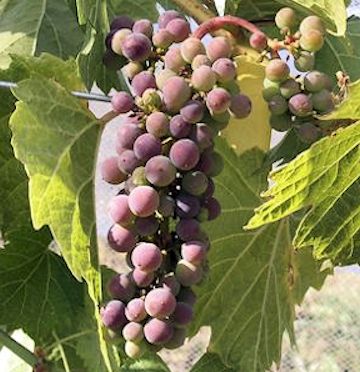 |
Petite Milo
Petite Milo: Another Valentin Blattner cross, this very early ripening pink grape is well suited to maritime climates such as Nova Scotia’s. It offers good potential for making stylish aromatic wines and as a useful component for blending. The grape is also finding a home on Vancouver Island and the Fraser Valley MT Lehman region.
- Pink coloured grape well suited to maritime climates such as NS.
- Developed recently in Switzerland by Vladimir Blattner.
- Based on a complex cross of cabernet sauvignon with the American species riparia & the Asian species amurensis.
- There is no labrusca grapes in its parentage thus avoiding a “foxy” character.
- The grapes are early ripening and disease resistant.
- This varietal can achieve high sugar levels while retaining good acidity.
- Wines produced can attain similar character to Alsatian style wines.
- The grapes and clusters on the vine are small and concentrated.
- Tropical fruit aromas can develop with wines from this varietal.
|
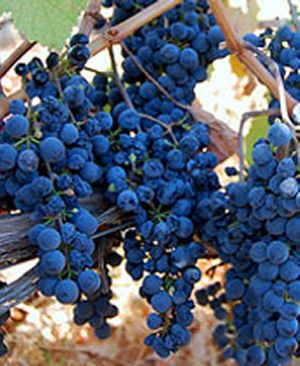 |
Petit Verdot is a variety of red wine grape , principally used in classic Bordeaux blends. It has attracted attention among winemakers in the New World , where it ripens well and has been made into single varietal wine. It is also useful in 'stiffening' the mid palate of Cabernet Sauvignon blends
Road 13 grows the varietal,Moon Curser,Osoyoos,makes a nice wine as does
Inniskillin. Wild Goose another fine Petit Verdot. Painted Rock Red Icon blends Petit Verdot as does Church and States'
Quintessential; both sensational wines. Also used by Clos du Soleil in their blends.
|
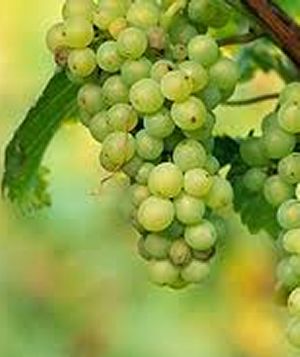 |
Pinot blanc is a white wine grape . It is a point genetic mutation of Pinot noir . Pinot noir is genetically unstable and will occasionally experience a point mutation in which a vine bears all black fruit except for one cane which produced white fruit.
Its chief flavour characteristics are freshness, yeasty and often apple-y aromas, and occasionally a hint of spice. It's not a wine for long lay-downs; it ages okay for a year or two but then starts to lose its luster
Gray Monk, Hester Creek, Lake Breeze, Stoneboat, Blue Mountain and Mission Hills all produces a nice Pinot Blanc wine.
|
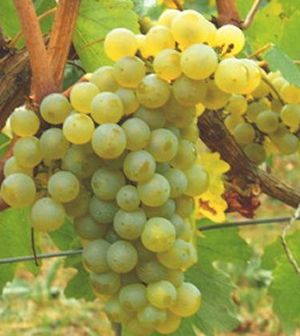 |
Pinot Gris perhaps the most popular BC grape around 11% of all grapes panted in BC.
Pinot gris (also known as pinot grigio ) is a white wine grape variety of the species Vitis vinifera . Thought to be a mutant clone of the Pinot noir grape, it normally has a grayish-blue fruit, accounting for its name ( gris meaning "grey" in French) but the grape can have a brownish pink to black and even white appearance. The word pinot , which comes from the word meaning "pine cone" in French, could have been given to it because the grapes grow in small pine cone-shaped clusters. The wines produced from this grape also vary in colour from a deep golden yellow to copper and even a light shade of pink.
Inniskillin Okanagan,
Pentâge, Blue Mountain, Hester Creek,Herder,Gray Monk, Domaine de Chaberton, Saxon wines, and Therapy all produce good Pinot Gris
it is also popular in Ontario
|
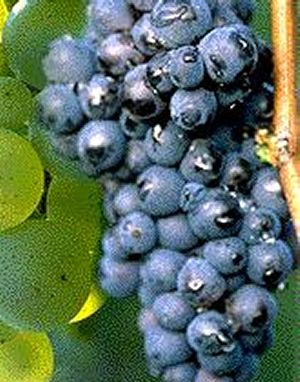 |
Pinot Meunier , pronounced: [pi.no mø.nje] , also known as Meunier or SchwarzRiesling , is a variety of black wine grape most noted for being one of the three main varieties used in the production of champagne (the other two are the black variety Pinot noir and the white Chardonnay ). Pinot Meunier is gaining recognition for the body and richness it contributes to Champagne ( Sparkling wines). It is a chimeric mutation of Pinot: its inner cell layers are composed of a Pinot genotype which is close to Pinot noir or Pinot gris; the outer, epidermal, layer is however made up of a mutant, distinctive, genotype. Pinot Meunier was first mentioned in the 16th century
8th Generation in Summerland makes a nice
Pinot Meunier Rose.
Also used by St Hubertus and Lake Breeze.
|
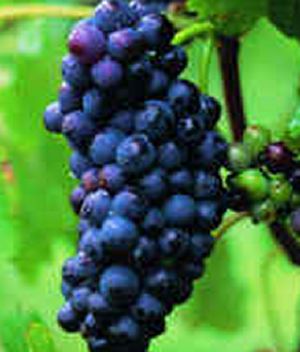 |
Pinot noir ( French: [pino nwa?] ) is a black wine grape variety of the species Vitis vinifera . The name may also refer to wines created predominantly from Pinot noir grapes. The name is derived from the French words for "pine" and "black" alluding to the grape variety's tightly clustered dark purple pine-cone shaped bunches of fruit.
Pinot noir grapes are grown around the world, mostly in the cooler regions, but the grape is chiefly associated with the Burgundy region of France . It is widely considered to produce some of the finest wines in the world, but is a difficult variety to cultivate and transform into wine.
Quality Pinot noir has been grown in Ontario for some time in the Niagara Peninsula and especially the Niagara-on-the-Lake and Short Hills Bench wine regions, as well as in Prince Edward County and on the north shore of Lake Erie . It has also been grown recently in the Okanagan , Lower Mainland , and Vancouver Island wine regions of British Columbia , the Annapolis Valley region of Nova Scotia and the Lanaudière and Brome-Missisquoi regions of Quebec
Tinhorn Creek Little Straw Vineyards,Black Cloud, Foxtrot,Serendipity Winery,Therapy Vineyard from the Okanagan are good producers.
Averill Creek Vineyard on Vancouver Island another good producer . For icewine
Paradise Ranch
|
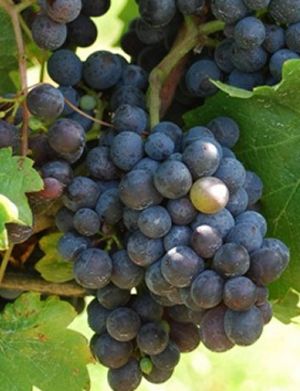 |
Pinotage a red wine grape that is South Africa's signature variety. It was bred there in 1925 as a cross between Pinot noir and Cinsaut (Cinsaut was known as "Hermitage" in South Africa during that time, hence the portmanteau name of Pinotage). It typically produces deep red varietal wines with smoky, bramble and earthy flavors, sometimes with notes of bananas and tropical fruit . Pinotage is often blended, and also made into fortified wine and even red sparkling wine . The grape is a viticultural cross of two varieties of Vitis vinifera , not a hybrid .
Lake Breeze Vineyards may have been the first winery in Canada to grow and produce Pinotage, Pinotage in BC is produced by The View Winery, Stoneboat, Hillside and
Inniskillin Okanagan
|
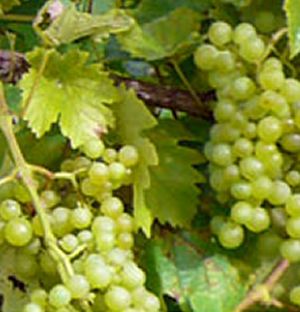 |
Reichensteiner is a white wine grape that is mainly grown in Germany (349 hectares (860 acres) and England acres It is a cross between Müller-Thurgau and Madeleine Angevine x Calabreser Froehlich , and was first bred in Germany during 1939.In England, it is the 2nd most grown after Seyval Blanc
Domaine de Chaberton grows Reichenstiner in the Fraser Valley. Ron Taylor winemaker at Sanduz Estate Winery
in Richmond grows the vine. Mistaken Identity blends Reichensteiner into some of their wines
|
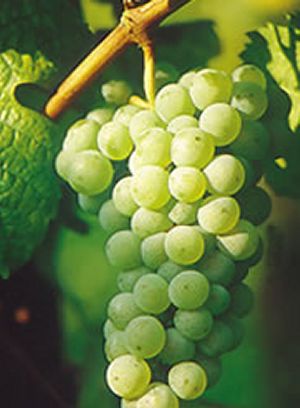 |
Riesling is a white grape variety which originated in the Rhine region of Germany . Riesling is an aromatic grape variety displaying flowery, almost perfumed, aromas as well as high acidity. It is used to make dry, semi-sweet, sweet and sparkling white wines . Riesling wines are usually varietally pure and are seldom oaked . It is usually included in the "top three" white wine varieties together with Chardonnay and Sauvignon Blanc . Riesling is a variety which is highly " terroir -expressive", meaning that the character of Riesling wines is clearly influenced by the wine's place of origin.
Ontario has always been know for its Riesling and its use in Icewine. In BC the grape is also popular and used in icewine.
CedarCreek in Kelowna is among Canada's Gold Medal producers. ST Hubertus, LA Frenz Winery, Wild Goose Vineyards, Fort Berens,
Tantalus Vineyards, SpierHead Winery, Gray Monk 8th Generation, Jackson-Triggs and Road 13 are all good producers
Icewine produces of note: Gehringer Bros,Sperling Vineyard,
Inniskillin, Paradise Ranch and Mission Hills
|
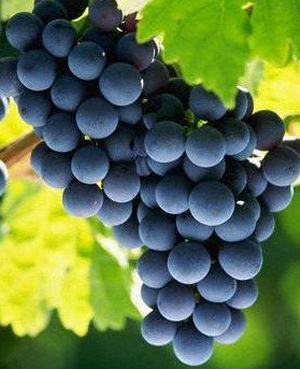 |
Rotberger is a wine grape variety . Its parentage is not known with certainty but it is thought to be from a cross of Trollinger and Riesling grapes). [ 1 ] Dr. Heinrich Birk (1898-1973) produced the cross at the Geisenheim Grape Breeding Institute in 1928. It is used to produce fruity , early maturing light red wines in cool-climate areas. It is often best drunk when young and can be used to produce a rosé or sparkling wine . It has no relationship with the Rotburger variety bearing a nearly similar name which is also known as Zweigelt .
Production of rotberger is quite small and primarily limited to Austria, Canada, Germany, and Liechtenstein.. It can be found in the Okanagan.
Gray Monk produces Rotberger
|
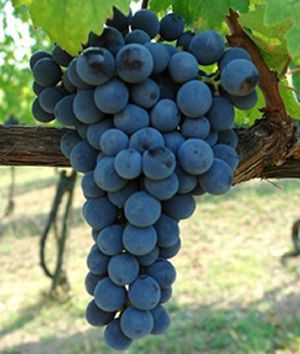 |
Sangiovese (san-jo- veh -zeh ) is a red Italian wine grape variety whose name derives from the Latin sanguis Jovis , "the blood of Jove ". The Young Sangiovese has fresh fruity flavours of strawberry and a little spiciness, but it readily takes on oaky, even tarry, flavors when aged in barrels. At least fourteen Sangiovese clones exist, of which Brunello is one of the best regarded.
Producers are Sandhill, Inniskillin Okanagan Vineyards
Ann Sperling of Sperling Vineyards produces a wine using Sangiovese called Sper..itz
|
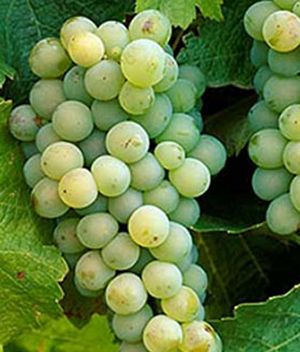 |
Sauvignon Blanc is a green-skinned grape variety which originates from the Bordeaux region of France . The grape most likely gets its name from the French word sauvage ("wild") and blanc ("white") due to its early origins as an indigenous grape in South West France .
Sauvignon blanc is planted in many of the world's wine regions, producing a crisp, dry, and refreshing white varietal wine .
Sauvignon Blanc is widely cultivated in France, Chile, Canada, Australia , New Zealand, South Africa, Brazil, Moldova and California .
The first thing you'll notice about Sauvignon Blanc is its instantly recognizable smell. It's often described as grassy or herbaceous , with notes of green fruit, such as gooseberry,
Good wine producers are Pentâge, Skaha Bench, Okanagan Valley, La Frenz on the Naramata Bench, Cassini in Oliver,
Stag's Hollow 2010 Sauvignon Blanc, Okanagan Valley and Clos du Soleil, Similkameen Valley
|
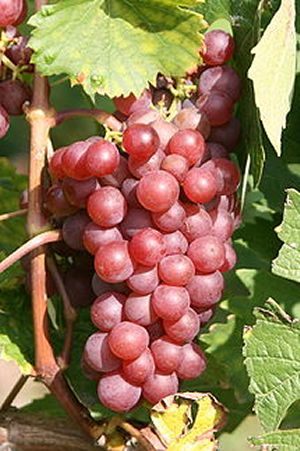 |
Schönburger , also spelled Schoenburger , or Schonburger is a variety of grape , formally designated Geisenheim 15-114, a crossing (of Pinot Noir, Chasselas,Muscat Hamburg ). developed at Geisenheim Institute for Grape Breeding in Germany , and released in 1979,
It is grown now in Germany, as well as in England where it is gaining popularity in the early 2000's. It can also be found in British Columbia, and in western Washington state , western Oregon state . A common feature of these areas is a cool climate, often maritime influenced .
Black Widow Winery makes a Schönburger.
Bartier Bros. Cowboy White blend uses it. also Stoneboat and vista d'oro.
Gehringer Brothers Estate Winery Classic Gewürztraminer - Schonberger is very good. also Morning Bay
Bianco A blend of Schonberger, Gewürztraminer, Pinot Gris and Riesling . Sunnybrae Vineyards in Tappin grows Schönburger
|
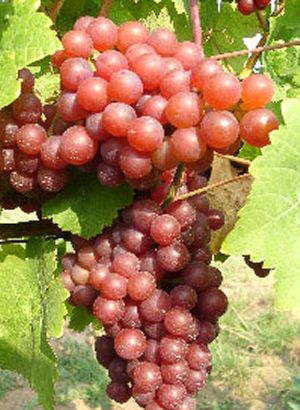 |
Siegerrebe (literally "Victory vine" in German ) is a white wine grape that is grown primarily in Germany with some plantings in England , Washington State , and British Columbia 's North Okanagan .
Siegerrebe was created by German viticulturalist Dr. Georg Scheu (1879-1949) in 1929 at a grape-breeding institute in Alzey in Rheinhessen , by crossing Madeleine Angevine and Gewürztraminer .
It is often used in blending
Gray Monk, Recline Ridge, Huning Hawk Sunnybrae Vineyards
and Blue Grouse are good producer. Larch Hill makes a nice Siegerrebe Dry Wine and dessert wine .Domain de Chaberton makes a nice
Siegerrebe Dessert Wine
|
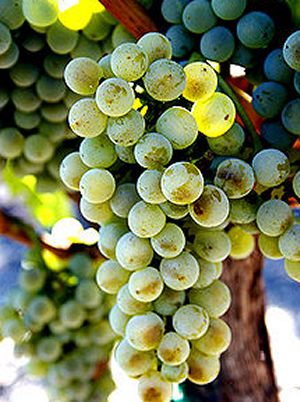 |
Sémillon is a golden-skinned grape used to make dry and sweet white wines , most notably in France and Australia .
Sémillon is one of the few white varieties (Riesling is the other) with a spectacular ability to age
Sémillon, which is relatively easy to cultivate, consistently produces six to eight tons of grapes per acre from its vigorous vines. It is fairly resistant to disease, except for rot. The grape ripens early, when, in warmer climates, it acquires a pinkish hue .Since the grape has a thin skin, there is also a risk of sunburn in hotter climates; it is best suited to areas with sunny days and cool nights.
The Sémillon grape is rather heavy, with low acidity and an almost oily texture. It has a high yield and wines based on it can age a long time.
La Frenz's Knorr vineyard in BC's Okanagan have some of the oldest vines in Canada.
Mt. Boucherie is another good producer.
|
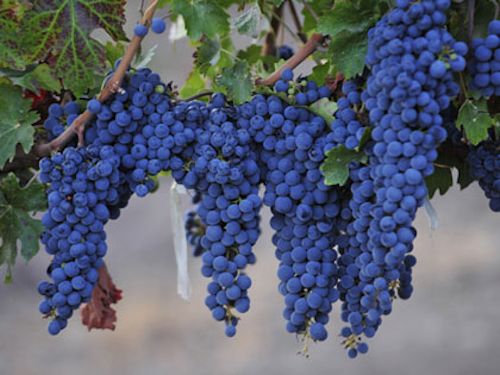 |
Syrah or Shiraz is a dark-skinned grape grown throughout the world and used primarily to produce powerful red wines . Whether sold as Syrah or Shiraz, these wines enjoy great popularity.
Syrah is used as a varietal and is also blended. Following several years of strong planting, Syrah was estimated in 2004 to be the world's 7th most grown grape. Syrah has a bright future in BC
Some outstanding producers include Black Hills, Cassini, Nk'Mip, Nichol, Township 7 Marichel Vineyard
and Church and State
|
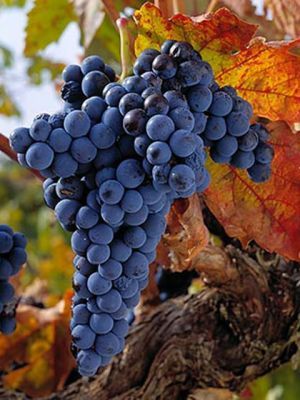 |
Tempranillo is a variety of black grape widely grown to make full-bodied red wines in its native Spain. Its name is the diminutive of the Spanish temprano ("early") a reference to the fact that it ripens several weeks earlier than most Spanish red grapes. and is often referred to as Spain's noble grape . Grown early in the 20th century to produce jug wines in California, toward the end of the 20th century Tempranillo enjoyed a renaissance there and throughout the world as a fine wine. The grape has been planted in New Zealand , South America , USA , South Africa , Australia , Argentina , Turkey and Canada
D'Angelo Estate Winery and Stag's Hallow led the way with this grape. Other good producers include Moon Curser Osoyoos, Okanagan and
Rocky Creek Winery on Vancouver Island.
|
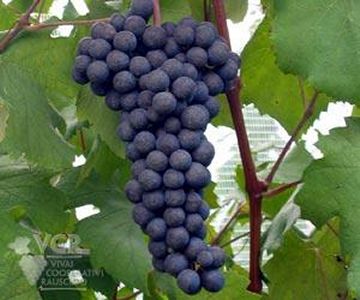 |
teroldego is a deeply colored red-wine grape grown in the Trentino-Alto Adige wine region of northern Italy. There is just one DOC for Teroldego ( Teroldego Rotaliano ) in its native Italy, and the variety is hardly cultivated anywhere else in the world. The Teroldego Rotaliano wines, from the flat, triangular-shaped plain of the Adige Valley, are made exclusively from local Teroldego grapes.
Teroldego produces deeply pigmented red wines with an intensely fruity characteristic, a style that has become something of an icon for Trentino's wine industry. Although Teroldego wine is rarely 'fine', it is soft-styled and needs very little aging to make it palatable. While it is usually drunk within three years of bottling, it can age well for up to 10 years.
The variety has recently been identified as one of the parents of Lagrein .
The grape has been intorduced into Canada BC growers are Stags Hollow and
Vindication Cellars
|
|
Trebbiano may the second most widely planted grape in the world. It gives good yields, but makes undistinguished wine at best. It can be fresh and fruity, but does not keep long. Its high acidity makes it important in Cognac production. Also known as Ugni Blanc , in particular in France, it has many other names reflecting a family of local subtypes, particularly in Italy and France
Hester Creek on the Golden Mile blends Trebbiano
|
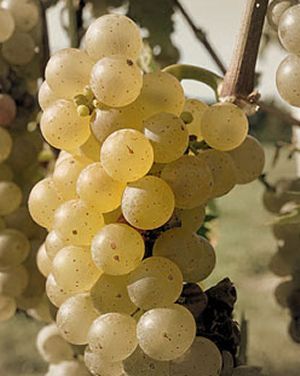 |
Vidal Blanc is an inter-specific hybrid variety of white wine grape , a cross of Ugni Blanc and Rayon d'Or (Seibel 4986). It manages to produce high sugar levels in cold climates while maintaining good acid levels.
Vidal Blanc was developed in the 1930s by French breeder Jean Louis Vidal ; his primary goal in developing the variety was to produce vines suitable for the production of Cognac in the Charente region of France . However, due to its winter hardiness this grape variety is cultivated most extensively in Canada and in the north-eastern United States . It is somewhat resistant to powdery mildew .
The wine produced from Vidal Blanc is fruity , with grapefruit and pineapple notes. Due to its high acidity and fruitiness it is particularly suited to sweeter, dessert wines . In particular, because of the tough outer skin of the fruit, it is well adapted for the production of icewine , especially in Ontario
In Canada's, quality wine-classification system, the Vintner's Quality Alliance (VQA), it is the only hybrid entitled to the highest category of quality. This is the Designated Viticultural Area (DVA) status. However, this honor is reserved for its Ice Wine incarnation only.
Arrowleaf 2010 Special Select Late Harvest Vidal, Okanagan Valley
Inniskillin Okanagan 2008 Vidal Icewine, Oliver, Okanagan Valley
Stag's Hallow Tragically Vidal 88 % Vidal 12 % Orange Muscat
Mission Hill Family Estate Vidal Icewine :
Ganton & Larsen Prospect Winery Vidal Icewine
|
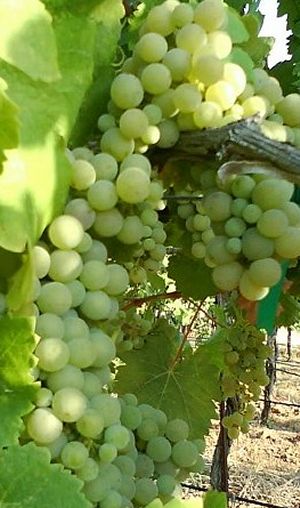 |
Viognier ( French pronunciation: [vi??je] ) is a white wine grape . It is the only permitted grape for the French wine Condrieu in the Rhone valley.
The use of Viognier in the United Sates and Canada is dramatically rising.
Viognier wines are well known for their floral aromas, due to terpenes , which are also found in Muscat and Riesling wines. There are also many other powerful flower and fruit aromas which can be perceived in these wines depending on where they were grown, the weather conditions and how old the vines were
The Okanagan Valley offers many excellent growing areas for Viognier, which needs to fully ripen in order for its tropical fruit and rich characters to shine. Many plots in the Southern parts of the valley offer the ideal conditions
Some good produces of Viognier are
Van Westen Vineyards, Road 13,La Frenz, Serendipity Winery, Saxon Wines,
Quinta Ferreira, Black Hills, Moon Cursor, and Stag's Hallow
A good blend
Le Vieux Pin 2009 Viognier-Roussanne
|
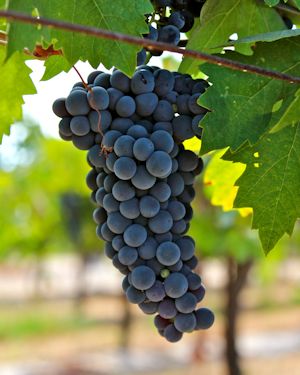 |
Zinfandel is a variety of red grape planted in over 10 percent of California vineyards . DNA fingerprinting revealed that it is genetically equivalent to the Croatian grapes Crljenak Kaštelanski and as well as Tribidrag the Primitivo variety traditionally grown in Puglia (the "heel" of Italy ), where it was introduced in the 18th century. The grape found its way to the United States in the mid-19th century, and became known by variations of the name "Zinfandel", a name of uncertain origin.
The grapes typically produce a robust red wine, although a semi-sweet rosé (blush-style) wine called White Zinfandel has six times the sales of the red wine in the United States. The grape's high sugar content can be fermented into levels of alcohol exceeding 15 percent.
The taste of the red wine depends on the ripeness of the grapes from which it is made. Red berry fruit flavors like raspberry predominate in wines from cooler areas
In recent years the grape has made it way into British Columbia with some success.
Inniskillin Okanagan (which claims to have made the Okanagan's first Zinfandel in 2002) is one producers. Two other early producers in BC were Road 13 and Rustico Farms. Other growers include Mt Boucherie,
Desert Hills,
Pentâge and
Quinta Ferreira
|
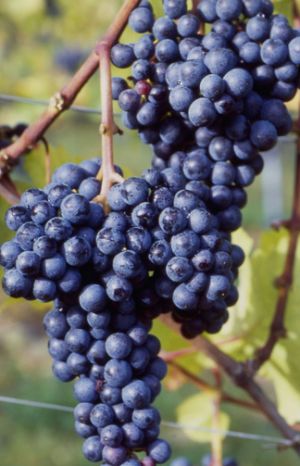 |
Zweigelt is a red wine grape variety developed in 1922, at the Federal Institute for Viticulture and Pomology Austria , by Fritz Zweigelt . It was a crossing of St. Laurent and Blaufränkisch . It is now the most widely-grown red grape variety in Austria.
The grape has practical mild disease resistance to the common mildews and is relatively cold hardy to approximately -20c.
Zweigelt vines have made in roads in the Canadian wine regions of Ontario 's Niagara Peninsula and of British Columbia.
Stonehill (no longer open) planted the first Zweigelt in British Columbia in 1997
Arrowleaf Cellars among the first planting 2 acres in 1999. Other producers include
Kalala Organic Estate Winery
Isabella winery in Richmond has a Zweigelt icewine as does
Summerhill Pyramid Winery in Kelowna.
|
Russian grape varieties: In 1973 cuttings from a number of grapes grown in what was then the Union of Soviet Socialist Republics were brought to British Columbia and planted in the Inkameep Vineyardsat Oliver. The varieties included: furmint (the variety that predominates in Hungary's sweet Tokay wines), matsvani, rkatsiteli, serekseya rozovaya and serekseya chornaya. For several years in the mid-1980s, Lynn Bremmerat Brights made interesting experimental wines from these varieties. When Stark left the winery, all were discontinued as varietals. Some of the varieties did not perform as well as hoped in British Columbia but even if they had, their tongue-twister names made them unwelcome in the marketing portfolio of a large winery.
Vivezza winery on Salt Spring Island grows Cortese. A centuries-old white-wine grape originating in the province of Alessandria in the Piedmont region of Italy. Cortese wines tend to be medium bodied with notes of limes and greengage. In vintages that are particularly cool, the wines can be aggressively acidic and lean, but winemaking techniques such as malolactic fermentation and oak barrel fermentation can temper that.
Another grape grown here is Epicure a grape variety that originates from British Columbia, Canada. While it’s not as widely known as some other grape varieties, it has its own unique characteristics. Let’s explore more about Epicure grapes:
Top 10 Varieties in order of acres 2025: • Merlot • Pinot Noir • Pinot Gris • Chardonnay • Cabernet Sauvignon • Cabernet Franc • Riesling • Gewürztraminer • Syrah • Sauvignon Blanc
Notes to self:
Arneis moon curser
Roussanne grown at Tinhorn Creek
Marsanne. road 13
Teroldego stag hallow
Madeleine Sylvaner
Itasca is named after Lake Itasca, the source lake for the Mississippi River, in northwestern Minnesota. It was released in 2017. This white wine grape variety stands out for its extreme cold hardiness, high quality fruit chemistry and low acidity, and disease resistance. Grown at The Perch.
Please see : Ontario ~ Nova Scotia ~ Quebec ~ New Brunswick ~ Newfoundland
Special Thanks goes to
~ Robert Murray
~ Erin Korpisto - vinesanddesigns
~ Andy Johnston - Averill Creek Winery
~ John Schreiner
~ Rayna @QuenchWines
~ Mark Holford Rocky Creek Winery
~ Wine Country BC / @ winecountrybc
~ BestofOkanagan/ @bestofOkanagan
~ Steve Latchford - Therapy
~ Joanne McIntyre Salt Spring Vineyards
~ Paul Troop
winemaker
~ Katherine Mackenzie - Red Rooster Winery
~ Dr. Andrew R. Jamieson
Fruit Breeding | Amélioration génétique des fruits
| Agriculture and Agri-Food Canada
(1) John Schreiner
Wineries of Canada
Home | About | Sitemap | Gallery | Contact
Us | New |©2020 Robert A Bell
|






















































